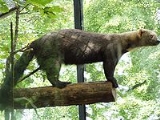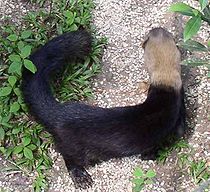
Tayra
Encyclopedia
The tayra also known as the Tolomuco or Perico ligero in Central America, and San Hol or viejo de monte in the Yucatan Peninsula
is an omnivorous
animal from the weasel family Mustelidae
. It is the only species
in the genus
Eira. There are at least nine known subspecies
.
, South America
and on the island of Trinidad
.
s and marten
s, growing to a size of about 60 cm, not including a 45 cm long tail. Most tayras have either dark brown or black fur with a lighter patch on its chest. The fur on its head changes to brown or gray as it ages. Tayras grow to weigh around 5 kilograms (11 pounds), ranging from 2.7 to 7.5 kg (6-16.5 pounds).
, does not display embryonic diapause
, otherwise known as delayed implantation (this reproductive strategy in other mustelids delays embryonic development and allows the female to delay birth of offspring until environmental factors are favorable). The female gives birth to 2 to 4 altricial
, black-coated young.


, but also consume carrion
, small mammal
s, reptiles, and bird
s. They live in hollow trees, burrow
s in the ground, or terrestrial nest
s made of tall grass
. Tayras are opportunistic eaters, hunting rodents and invertebrates, and climbing trees to get eggs
and honey
. In Central Brazil they are called "Papa Mel" (honey eater). They are attracted to fruit and can be found raiding orchards.
An interesting instance of caching
has been observed among tayras: a tayra will pick unripe green plantain
s, which are inedible, and leave them to ripen in a cache, coming back a few days later to consume the softened pulp.
for agricultural purposes. Though the species as a whole is listed as a Least Concern
species, the northernmost subspecies, Eira barbara senex, is listed as Vulnerable
by the IUCN.
Yucatán Peninsula
The Yucatán Peninsula, in southeastern Mexico, separates the Caribbean Sea from the Gulf of Mexico, with the northern coastline on the Yucatán Channel...
is an omnivorous
Omnivore
Omnivores are species that eat both plants and animals as their primary food source...
animal from the weasel family Mustelidae
Mustelidae
Mustelidae , commonly referred to as the weasel family, are a family of carnivorous mammals. Mustelids are diverse and the largest family in the order Carnivora, at least partly because in the past it has been a catch-all category for many early or poorly differentiated taxa...
. It is the only species
Monotypic
In biology, a monotypic taxon is a taxonomic group with only one biological type. The term's usage differs slightly between botany and zoology. The term monotypic has a separate use in conservation biology, monotypic habitat, regarding species habitat conversion eliminating biodiversity and...
in the genus
Genus
In biology, a genus is a low-level taxonomic rank used in the biological classification of living and fossil organisms, which is an example of definition by genus and differentia...
Eira. There are at least nine known subspecies
Subspecies
Subspecies in biological classification, is either a taxonomic rank subordinate to species, ora taxonomic unit in that rank . A subspecies cannot be recognized in isolation: a species will either be recognized as having no subspecies at all or two or more, never just one...
.
Range and habitat
Tayras live in the tropical forests of Central AmericaCentral America
Central America is the central geographic region of the Americas. It is the southernmost, isthmian portion of the North American continent, which connects with South America on the southeast. When considered part of the unified continental model, it is considered a subcontinent...
, South America
South America
South America is a continent situated in the Western Hemisphere, mostly in the Southern Hemisphere, with a relatively small portion in the Northern Hemisphere. The continent is also considered a subcontinent of the Americas. It is bordered on the west by the Pacific Ocean and on the north and east...
and on the island of Trinidad
Trinidad
Trinidad is the larger and more populous of the two major islands and numerous landforms which make up the island nation of Trinidad and Tobago. It is the southernmost island in the Caribbean and lies just off the northeastern coast of Venezuela. With an area of it is also the fifth largest in...
.
Description
Tayras have an appearance similar to weaselWeasel
Weasels are mammals forming the genus Mustela of the Mustelidae family. They are small, active predators, long and slender with short legs....
s and marten
Marten
The martens constitute the genus Martes within the subfamily Mustelinae, in family Mustelidae.-Description:Martens are slender, agile animals, adapted to living in taigas, and are found in coniferous and northern deciduous forests across the northern hemisphere. They have bushy tails, and large...
s, growing to a size of about 60 cm, not including a 45 cm long tail. Most tayras have either dark brown or black fur with a lighter patch on its chest. The fur on its head changes to brown or gray as it ages. Tayras grow to weigh around 5 kilograms (11 pounds), ranging from 2.7 to 7.5 kg (6-16.5 pounds).
Reproduction
The tayra, unlike other MustelidaeMustelidae
Mustelidae , commonly referred to as the weasel family, are a family of carnivorous mammals. Mustelids are diverse and the largest family in the order Carnivora, at least partly because in the past it has been a catch-all category for many early or poorly differentiated taxa...
, does not display embryonic diapause
Embryonic diapause
Delayed Implantation or Embryonic Diapause is a reproductive strategy used by approximately 100 different mammals in seven or eight different orders. In embryonic diapause, the embryo does not immediately implant in the uterus, but is maintained in a state of dormancy. Little to no development...
, otherwise known as delayed implantation (this reproductive strategy in other mustelids delays embryonic development and allows the female to delay birth of offspring until environmental factors are favorable). The female gives birth to 2 to 4 altricial
Altricial
Altricial, meaning "requiring nourishment", refers to a pattern of growth and development in organisms which are incapable of moving around on their own soon after hatching or being born...
, black-coated young.


Behavior
They travel both alone and in groups during both the day and the night. Tayras are expert climbers, and can leap from treetop to treetop when pursued; they can also run fast and swim well.Diet
They eat mainly fruitFruit
In broad terms, a fruit is a structure of a plant that contains its seeds.The term has different meanings dependent on context. In non-technical usage, such as food preparation, fruit normally means the fleshy seed-associated structures of certain plants that are sweet and edible in the raw state,...
, but also consume carrion
Carrion
Carrion refers to the carcass of a dead animal. Carrion is an important food source for large carnivores and omnivores in most ecosystems. Examples of carrion-eaters include vultures, hawks, eagles, hyenas, Virginia Opossum, Tasmanian Devils, coyotes, Komodo dragons, and burying beetles...
, small mammal
Mammal
Mammals are members of a class of air-breathing vertebrate animals characterised by the possession of endothermy, hair, three middle ear bones, and mammary glands functional in mothers with young...
s, reptiles, and bird
Bird
Birds are feathered, winged, bipedal, endothermic , egg-laying, vertebrate animals. Around 10,000 living species and 188 families makes them the most speciose class of tetrapod vertebrates. They inhabit ecosystems across the globe, from the Arctic to the Antarctic. Extant birds range in size from...
s. They live in hollow trees, burrow
Burrow
A burrow is a hole or tunnel dug into the ground by an animal to create a space suitable for habitation, temporary refuge, or as a byproduct of locomotion. Burrows provide a form of shelter against predation and exposure to the elements, so the burrowing way of life is quite popular among the...
s in the ground, or terrestrial nest
Nest
A nest is a place of refuge to hold an animal's eggs or provide a place to live or raise offspring. They are usually made of some organic material such as twigs, grass, and leaves; or may simply be a depression in the ground, or a hole in a tree, rock or building...
s made of tall grass
Grass
Grasses, or more technically graminoids, are monocotyledonous, usually herbaceous plants with narrow leaves growing from the base. They include the "true grasses", of the Poaceae family, as well as the sedges and the rushes . The true grasses include cereals, bamboo and the grasses of lawns ...
. Tayras are opportunistic eaters, hunting rodents and invertebrates, and climbing trees to get eggs
Egg (biology)
An egg is an organic vessel in which an embryo first begins to develop. In most birds, reptiles, insects, molluscs, fish, and monotremes, an egg is the zygote, resulting from fertilization of the ovum, which is expelled from the body and permitted to develop outside the body until the developing...
and honey
Honey
Honey is a sweet food made by bees using nectar from flowers. The variety produced by honey bees is the one most commonly referred to and is the type of honey collected by beekeepers and consumed by humans...
. In Central Brazil they are called "Papa Mel" (honey eater). They are attracted to fruit and can be found raiding orchards.
An interesting instance of caching
Hoarding (animal behavior)
Hoarding or caching is a type of animal behavior where an animal will store its food in times of surplus for times when food is less plentiful...
has been observed among tayras: a tayra will pick unripe green plantain
Plantain
Plantain is the common name for herbaceous plants of the genus Musa. The fruit they produce is generally used for cooking, in contrast to the soft, sweet banana...
s, which are inedible, and leave them to ripen in a cache, coming back a few days later to consume the softened pulp.
Tayras and people
Tayras are playful and easily tamed. Indigenous people, who often refer to the tayra as "cabeza del viejo", or old man's head, due to their wrinkled facial skin, have kept them as household pets to control vermin.Conservation
Wild tayra populations are slowly shrinking, especially in Mexico, due to habitat destructionHabitat destruction
Habitat destruction is the process in which natural habitat is rendered functionally unable to support the species present. In this process, the organisms that previously used the site are displaced or destroyed, reducing biodiversity. Habitat destruction by human activity mainly for the purpose of...
for agricultural purposes. Though the species as a whole is listed as a Least Concern
Least Concern
Least Concern is an IUCN category assigned to extant taxon or lower taxa which have been evaluated but do not qualify for any other category. As such they do not qualify as threatened, Near Threatened, or Conservation Dependent...
species, the northernmost subspecies, Eira barbara senex, is listed as Vulnerable
Vulnerable species
On 30 January 2010, the IUCN Red List of Threatened Species identified 9694 Vulnerable species, subspecies and varieties, stocks and sub-populations.-References:...
by the IUCN.
Subspecies
- Eira barbara barbara (northern Argentina, Paraguay, western Bolivia and central Brazil)
- Eira barbara biologiae (central Costa Rica and Panama)
- Eira barbara inserta (South Guatemala to central Costa Rica)
- Eira barbara madeirensis (west Ecuador and northern Brazil)
- Eira barbara peruana (the Andes in Peru and Bolivia)
- Eira barbara poliocephala (Guyana, eastern Venezuela and Brazil)
- Eira barbara senex (central Mexico to northern Honduras)
- Eira barbara senilis (northern Ecuador)
- Eira barbara sinuensis (Colombia and western Venezuela)

